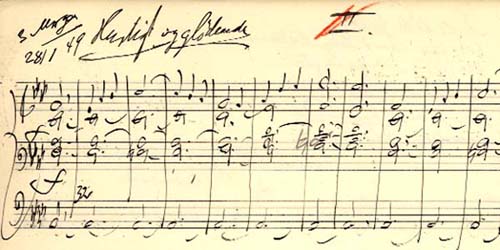Aspects & Points
Repetitive Techniques 1
Repetitive techniques - repetitions of the same little motif or of larger passages several times in sequence - is one of Langgaard's special characteristics. The effects achieved by the composer in this way are the maintenance of a particular tone, and the imparting of a static character to the passage in question. In Sfærernes Musik (Music of the Spheres) (1916-18) repetitive motifs are to be found in a wide variety of forms. Other characteristic examples are the 'minimalist' 2nd Movement of the choral cycle, Rosengårdsviser (Rosengård Ballads) (1919) and several passages in Humoreske (Humouresque) (1922-23) for wind instruments and percussion.
Repetitive techniques were also used by Langgaard in the later years of his career. The strange composition, Hermod (1949), written for four voices and nine instruments, ends with an 8-bar passage which is circular in character, and which is to be repeated many times to indicate that the march of time has been stopped.
Another form of repetition is found in those works based on varied repetitions. Symphony No. 11 Ixion (1944- 45), and the organ piece Øde Gader (Deserted Streets) (1949) are based on short themes that provide the whole substance of the music.
Listen to the whole of Øde Gader or perhaps just
the beginning, which in Langgaard's manuscript looks like this:

This sample of the music is reproduced with the permission of Edition Egtved.
![]()